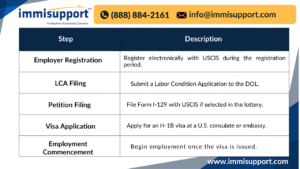Premier LPO for Immigration Attorneys, Offering Round-the-Clock Support!
Discover the Most Advanced and Effective Immigration Services
Browse Specialty Staffing ServicesReal-Time Mailing Services: How Paralegals Manage Critical Immigration Documents?

It was an early Thursday morning in San Francisco, and the office was buzzing with activity. Attorneys John and Jan were reviewing their latest I-129 petition for an H-1B visa sponsorship. The deadline was fast approaching, and they needed to ensure everything was in order. As they discussed the intricacies of the H-1B visa sponsorship process, they realized how crucial it was to follow each step carefully to avoid any missteps.
A Conversation Between Two Top Attorneys John Doe and Jan Doe:
John:
“Jan, this I-129 petition is more complicated than we expected. We have to ensure the Labor Condition Application (LCA) is filed first, and then wait for the lottery results. This process seems long, but we need to get it right.”
Jan:
“Yes, and let’s not forget the prevailing wage requirements. The wage offered must meet or exceed the prevailing wage for the position in the area of intended employment. That’s key to a successful petition.”
John:
“You’re right. And the public access file requirements are another layer of complexity. We need to maintain a file accessible to the public, detailing the terms and conditions of employment.”
Jan:
“Absolutely. And with the cap on H-1B visas, we need to stay updated on any changes in the process. Luckily, we’re not doing this alone—we have ImmiSupport’s outsourcing services to ensure all paperwork is filed accurately and on time.”
Key Steps in the H-1B Visa Sponsorship Process
The H-1B visa sponsorship steps for employers involve several crucial stages that employers need to follow to ensure they are compliant with USCIS requirements. From initial registration to the final visa approval, here’s a breakdown of the process.
Step 1: Employer Registration
Before filing the petition, employers must register electronically with USCIS during the designated registration period. This step is crucial for entering the lottery process and securing a spot for visa selection.
Step 2: Filing the Labor Condition Application (LCA)
Once registered, the employer needs to file a Labor Condition Application (LCA) with the U.S. Department of Labor (DOL). The LCA attests that the wage offered meets the required level for the occupation and ensures fair working conditions for the foreign worker.
Step 3: Filing the Petition (Form I-129)
After the lottery results, employers can proceed to file Form I-129 along with the certified LCA and any other required documentation, including proof of the worker’s qualifications and the company’s need for their expertise.
Step 4: Visa Application
Once USCIS approves the petition, the foreign worker applies for the H-1B visa at a U.S. consulate or embassy abroad, if applicable. This step is vital for workers outside the U.S.
Step 5: Commencement of Employment
Once the visa is approved, the employee can legally work in the U.S. under the H-1B status. The employee can begin their employment as soon as they receive the visa and are granted entry into the country.
H-1B Visa Sponsorship Process Overview

Key Responsibilities for Employers
Employers who wish to sponsor an H-1B visa for a foreign worker must adhere to specific regulations and responsibilities throughout the process.
-
Wage Compliance: Employers must ensure the wage offered to the employee meets or exceeds the prevailing wage as outlined by the Department of Labor.
-
Public Access File Maintenance: Employers must keep a public access file with detailed information about the job, wages, and work conditions.
-
Record Keeping: It’s essential for employers to keep thorough records of the H-1B petitions, including the LCA filings and any updates to the employee’s terms of employment. Additionally, maintaining these records ensures compliance with USCIS regulations and helps avoid potential issues in the future.
-
Notifying the DOL: Moreover, if there are any significant changes in the terms and conditions of employment, employers must promptly inform the DOL. Failure to do so could lead to penalties or complications with the H-1B petition.
What Did We Learn?
-
The H-1B visa sponsorship process involves multiple crucial steps: employer registration, LCA filing, petition submission, visa application, and employment commencement.
-
Employers must fulfill specific responsibilities, such as ensuring wage compliance, maintaining a public access file, and keeping accurate records.
-
Staying updated and organized is key to successfully navigating the H-1B visa sponsorship process.
What People Are Asking?
1.What is the H-1B visa sponsorship process for employers?
The process involves registering with USCIS, filing an LCA, submitting a petition, applying for a visa, and commencing employment.
2.What are the employer responsibilities in H-1B sponsorship?
Employers must ensure wage compliance, maintain a public access file, and notify the DOL of any employment changes.
3.How can outsourcing services help in the H-1B process?
Outsourcing services, like those offered by ImmiSupport, can streamline the paperwork process, ensure timely filings, and help you stay compliant with USCIS regulations.
4.What should be included in the public access file for H-1B workers?
The public access file should include the LCA, wage rates, and any modifications to the terms of employment.
5.What happens after the H-1B visa is approved?
Once the visa gets approved, the employee can enter the U.S. and start working under the H-1B status. The employer can now officially assign tasks and integrate the employee into the workforce.
Disclaimer
For informational purposes only; not applicable to specific situations.
For tailored support and professional services,
please contact Immisupport, at +1 888 884 2161
Email: info@immisupport.com
Book a Demo:Â https://immisupport.com/demo/
 Book a Demo To Build Your Team Today!
Book a Demo To Build Your Team Today!
 Read Case Studies
Read Case Studies 


 Immigration Virtual Paralegal Assistants
Immigration Virtual Paralegal Assistants Immigration Client Acquisition
Immigration Client Acquisition Digital Marketing Assistants
Digital Marketing Assistants Immigration Video Hosting
Immigration Video Hosting Website Design Assistants
Website Design Assistants Domestic Mailing & Scanning Assistants
Domestic Mailing & Scanning Assistants AI Voice Chat Assistants
AI Voice Chat Assistants



